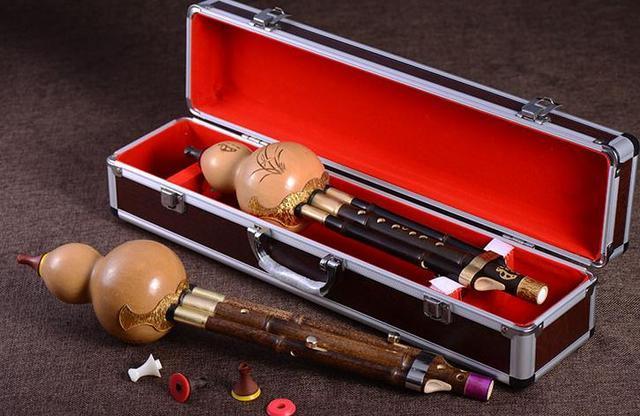Teach you to develop a sense of rhythm in playing cucurbit flute
Today I will tell you how to develop a sense of rhythm in music performance. I believe that many beginners will have a puzzle that cannot be solved, that is, they always have a bad grasp of the rhythm of the song. When practicing with the accompaniment, they are out of touch with the original rhythm. When playing some cucurbit flute songs, the old It's a wrong shot, it's either too fast or too slow. The first sixteen notes, the last ten flutters, the quarter notes, the eighth notes, the whole notes are a lot of things I don't understand. Rhythm is the most fundamental and important premise of musical performance. Without rhythm, there is no music.
In learning cucurbit flute, a moving piece of music can arouse our emotions, so rhythm is the "lifeline" of music art. Many people have a slow cognition of rhythm and do not have the correct concept of rhythm, so they cannot feel the beauty brought by music! So what is rhythm? It is the accurate grasp of the beat of the rhythm unit. If there is a lack of rhythm, how can it be improved?
Point 1: What rhythms are easy to miss?
1. When beginners start to learn musical instruments, they often show that the speed of playing is not stable. For example, when a quarter note and a half note appear in a piece of music, often when children play a quarter note, the actual performance is as long as the half note. Although he counted one beat, he didn't realize how many beats he actually played.
2. You can maintain the correct rhythm when the teacher or parent helps you beat the beat, but when you practice independently, it will be fast and slow.
3. There are always two situations of "too long" and "too fast" when playing, and there is no correct concept of rhythm.

Point 2:So how can beginners, middle-aged and elderly people improve their sense of rhythm?
Point 1: Sing
1. Recognize clef, time signature, key signature, and temporary diacritics. Look for various notes and rests.
2. Find the right time and sing the notes of the correct rhythm.
3. Get familiar with the melody.
4. Find out the various markings on the score, such as fingering and playing.
5. Know what you have in mind.
6. Develop good reading habits.
7. Cultivate a sense of music.
It really does kill seven birds with one stone.
Point 2: teachers or parents and friends help
During the performance or in class, teachers and parents can help beat the beat, or let the children clap their hands while demonstrating the playing. As a number, 1.2.3.ta 2.2.3.ta. Counting like this, you can also use the palm of your hand to cooperate!
Point 3: use the metronome
For beginners who love to drag the beat or catch the beat, use the fixed rhythm point of the metronome to train and fix the inner rhythm, and slowly develop the good habit of strengthening the number of beats, so that the inner rhythm can be stabilized very quickly. sense.
There is also a little secret, that is to listen to the sound of the metronome more, listen to it if you have nothing to do, don't adjust the speed too fast, look for this feeling, da .da .da. da. These sounds can be played in four or two beats, four or three The sound of four or four beats, I will feel this way when I listen to it a lot!

Point 3: analyze the difference between different rhythms
You can mark the rhythm pattern separately for practice, and use the form of clapping your hands or tapping the table to accurately hit the same beats as 2/4 strong and weak, 3/4 strong and weak, and understanding from the fun will deepen your understanding of the rhythm. understand. The rhythm characteristics of the four-beat are relatively square, and the sense of beat is "strong, weak, second strong, weak". The rhythm characteristic of triple time is like a rotating circle, and the sense of beat is "strong, weak, weak".
Point 4:learn to listen
Music is an art of hearing, which must be heard and perceived with the ears. Rhythms are everywhere, and we can personally experience the various rhythms in life, such as clocks and watches "did dah dah"; when going upstairs "tom tom tom tom"; when going downstairs "tap tap tap"...
And when you are playing the cucurbit flute, you must prick up your ears to listen to your own music and pay attention to your own speed handling. The handling of note skills will be very ambiguous. Many people are very ambiguous in voicing, and the spit is not clear, and it sounds very fast. If you listen carefully, there are many problems. The professional judges and teachers specially deduct these contestants. If the pronunciation is good or not, it is not clear, and the spit is clean and clear, indicating that the basic skills are solid and generally high scores. If beginners or middle-aged and elderly people have these vague problems , the solution is to slowly practice and blow a hundred times to overcome! If you want to be proficient, you have to do it a hundred times. If you want to be proficient, it must be thousands of times, all of which are accumulated over several years! You just blew it a dozen times before you say you're very skilled. That doesn't work!
After understanding these truths, you must accurately grasp the timing of each beat, and after the beat is accurate, and then show the clear rhythm and rhythm of the music. The music played in this way is beautiful and beautiful, and I believe everyone will make progress.
 渝公网安备 50010702504639号
渝公网安备 50010702504639号